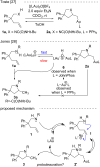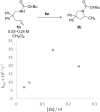Ligand effects, solvent cooperation, and large kinetic solvent deuterium isotope effects in gold(I)-catalyzed intramolecular alkene hydroamination
- PMID: 38440168
- PMCID: PMC10910400
- DOI: 10.3762/bjoc.20.43
Ligand effects, solvent cooperation, and large kinetic solvent deuterium isotope effects in gold(I)-catalyzed intramolecular alkene hydroamination
Abstract
Kinetic studies on the intramolecular hydroamination of protected variants of 2,2-diphenylpent-4-en-1-amine were carried out under a variety of conditions with cationic gold catalysts supported by phosphine ligands. The impact of ligand on gold, protecting group on nitrogen, and solvent and additive on reaction rates was determined. The most effective reactions utilized more Lewis basic ureas, and more electron-withdrawing phosphines. A DCM/alcohol cooperative effect was quantified, and a continuum of isotope effects was measured with low KIE's in the absence of deuterated alcoholic solvent, increasing to large solvent KIE's when comparing reactions in pure MeOH to those in pure MeOH-d4. The effects are interpreted both within the context of a classic gold π-activation/protodeauration mechanism and a general acid-catalyzed mechanism without intermediate gold alkyls.
Keywords: alkene hydroamination; general acid catalysis; gold catalysis; isotope effect; phosphine ligand effect; solvent effect.
Copyright © 2024, Lan et al.
Figures










Similar articles
-
Ylide-Substituted Phosphines: A Platform of Strong Donor Ligands for Gold Catalysis and Palladium-Catalyzed Coupling Reactions.Acc Chem Res. 2022 Mar 1;55(5):770-782. doi: 10.1021/acs.accounts.1c00797. Epub 2022 Feb 16. Acc Chem Res. 2022. PMID: 35170935
-
[Ir(COD)Cl]2 as a catalyst precursor for the intramolecular hydroamination of unactivated alkenes with primary amines and secondary alkyl- or arylamines: a combined catalytic, mechanistic, and computational investigation.J Am Chem Soc. 2010 Jan 13;132(1):413-26. doi: 10.1021/ja908316n. J Am Chem Soc. 2010. PMID: 20000354
-
Improving Homogeneous Cationic Gold Catalysis through a Mechanism-Based Approach.Acc Chem Res. 2019 May 21;52(5):1275-1288. doi: 10.1021/acs.accounts.8b00544. Epub 2019 Apr 19. Acc Chem Res. 2019. PMID: 31002231
-
Gold(I)-Catalysed Asymmetric Hydroamination of Alkenes: A Silver- and Solvent-Dependent Enantiodivergent Reaction.Chemistry. 2017 Aug 10;23(45):10777-10788. doi: 10.1002/chem.201701301. Epub 2017 Jun 29. Chemistry. 2017. PMID: 28488394
-
2-Aminoalkylgold Complexes: The Putative Intermediate in Au-Catalyzed Hydroamination of Alkenes Does Not Protodemetalate.Chemistry. 2022 Jul 6;28(38):e202200332. doi: 10.1002/chem.202200332. Epub 2022 May 27. Chemistry. 2022. PMID: 35319803 Free PMC article.
References
LinkOut - more resources
Full Text Sources
Research Materials
Miscellaneous
